Naqsh-e Jahan Square, formerly known as Shah Square or the Royal Square (and after the Iranian Revolution of 1979 with the official name of Imam Square), is the central square of Isfahan, which is located in the heart of the historical complex of Naqsh-e Jahan.

History of Naqsh-e Jahan Square
Historical monuments on the four sides of Naqsh Jahan Square include Aali Qapu Palace, Shah Mosque (Imam Mosque), Sheikh Lotfollah Mosque and Qeysarieh Gate, which is the main entrance of Isfahan Bazaar. In addition, there are two hundred two-story shops around the square, which are generally a market for Iranian Art and handicrafts. Before the city of Isfahan was chosen as the capital of Safavid Empire, there had been a Naqsh-e Jahan garden that was also the location of government buildings and the palace of the Timurid and Agh Quyunlu rulers.
The construction of the square in its current form was performed during the reign of Shah Abbas I in 1598. Two architects called Mohammad Reza Isfahani and Ali Akbar Isfahani are known as designers and builders of the square who built it in its current form. The names of these two architects can be seen on the entrances of the buildings around the square. Sheikh Baha’i has also been in charge of designing and supervising the construction of some surrounding structures. The French traveler Jean Chardin who traveled to Isfahan in 1673, called Naqsh-e-Jahan the most beautiful square in the world.
Function
During the reign of Shah Abbas the Great and his successors, this square was prepared for polo matches, army parades, lighting, and various shows during the days of royal celebrations, and on other days it was a place for people to walk and shop. Two pairs of polo stone goal posts still remain on the sides of the field referred to as the oldest polo goal posts in the world.
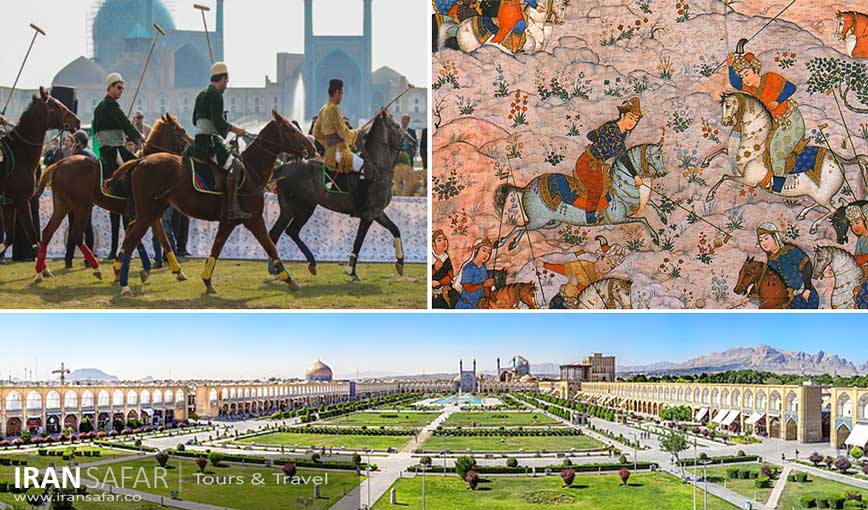
The Naqsh Jahan square was also the site of massive Friday markets. One of the first official ceremonies held in this square was a feast in honor of the triumphant return of Imam Gholi Khan from the conquest of Hormoz Island to the capital (Isfahan). Chardin quotes that up to 50,000 lights were lit in the square during the festivities. Detailed description of this square has been given by famous European travelers such as Chardin, Jean-Baptiste Tavernier, Pietro Delavalle, Sanson, Engelbert Kempfer and others who have visited Isfahan since Safavid times, and all of them have praised the beauty of the square. After the victory of the Islamic Revolution, this square is also a place for holding Friday prayers and political gatherings.
Places to visit at Naqsh-e Jahan Square
Each of the historical monuments built in this square was a symbol of civil life, urban community and also national solidarity. The Abbasi Grand Mosque or Shah Mosque on the south side of the square served as the largest social center of Isfahan. This mosque was built for large gatherings of people on various occasions. Sheikh Lotfollah Mosque on the east side of the square was a private religious center for the royal family , and Aali Qapu palace located on the west side of square was the main government building.
The length of Naghsh Jahan Square is more than 525 meters and its width reaches 160 meters. The square is surrounded by 200 shops that form a fantastic hadicraft market.
Naqsh-e Jahan Square Plan
Click on the image to enlarge
Aali Qapu Palace
Aali Qapu Palace in Naghsh Jahan Square of Isfahan is one of the most beautiful examples of Safavid architecture. Aali Qapu building attracts the attention of many domestic and foreign visitors with its outstanding architecture and remarkable decorations by famous Iranian artists. The most important parts of Aali Qapu Palace are the entrance to the palace, luxurious halls, music hall on the top floor and prominent works of art in different parts of the palace. The main foundations of this mansion are built of wood, and this adds to the architectural appeal of this place.
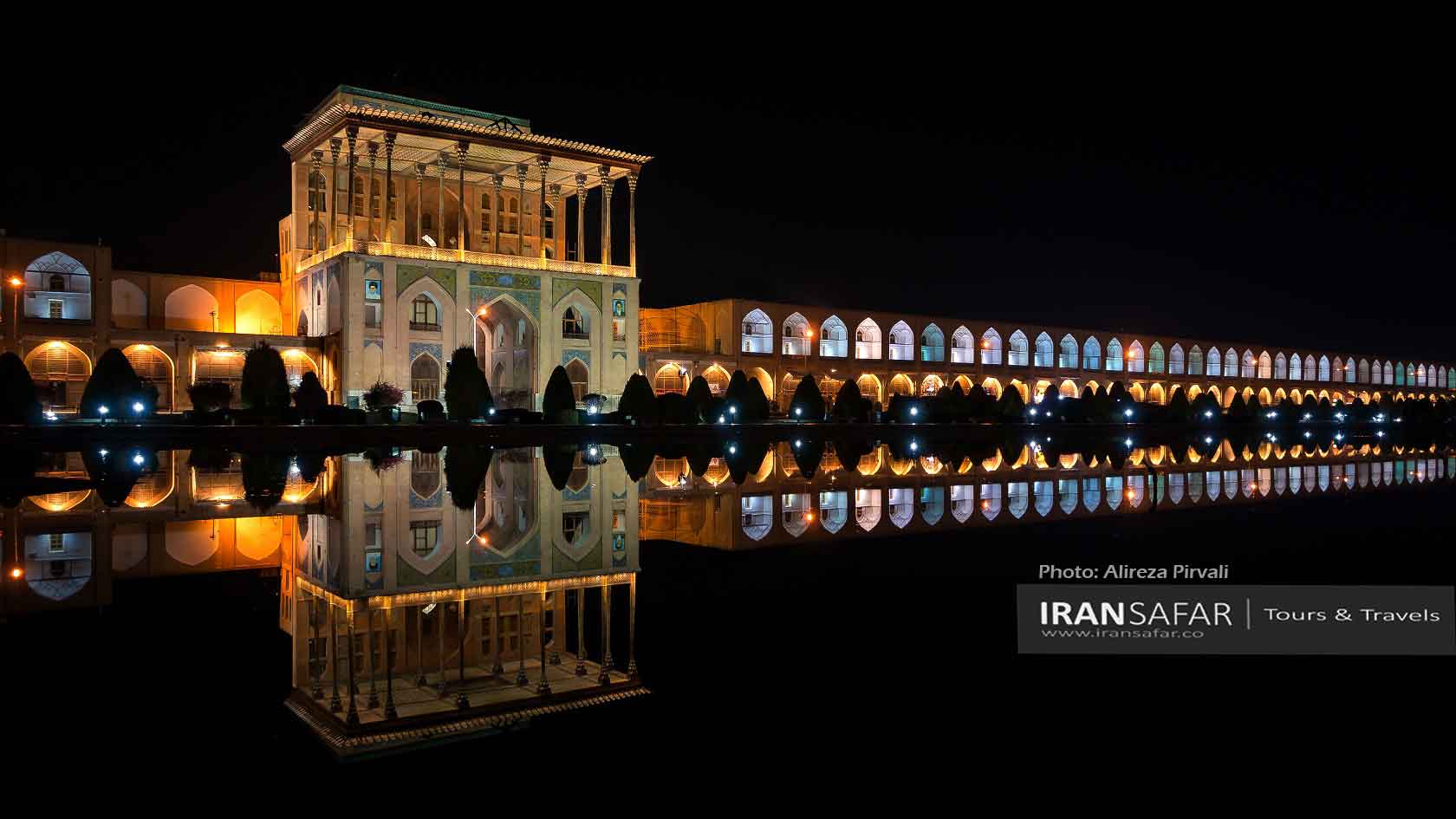 Aali Qapu Palace, Isfahan, Iran
Aali Qapu Palace, Isfahan, Iran
During the Safavid Era, architecture style and ornamentation of built structures were among the most important arts. The Safavid constructions in Iran are probably the most attractive monuments throughout Iranian architecture. Artists and architects of Safavid Period have left masterpieces of art, most of which were executed on the orders of Shah Shah Abbas І, who was an art lover king. A collection of remarkable buildings, including Chehel Sotoun Palace, Hasht Behesht, Mirror Hall, Namakdan pavilion, Ashraf Hall, etc. were all constructed in this magnificent period.
The Aali Qapu Palace is one of the buildings that have undergone many changes during decades and it was expanded during the reign of Shah Abbas the great and was officially used for formal occasions, gatherings, meetings and also a royal balcony to watch games and cometions. This site is located on the west side of Naghsh-e Jahan Square, in front of Sheikh Lotfollah Mosque. In the past, the Aali Qapo mansion was also referred to as the “blessed government house” or the “palace of the government”. The Palace has an area of 1800 square meters and 6 floors.
The word “Aali Qapu” consists of two parts, Aali and Qapu, which together mean “High Gate”. Aali Qapu Palace, with its beautiful wood-based architecture, is one of the largest and most magnificent buildings of its time and was built in the early 17th century. It is a 6-storey building with a height of about 48 meters. In this building, different floors are connected to each other by three narrow stair cases. On the first floor, there are two main halls called “Sadr Khaneh” or “Kashik Khaneh”, used for administrative affairs.
One of the most beautiful part of the Aali Qapu Palace is the music hall located on the top floor. On the walls and ceiling of this hall, there are beautiful plaster work with delicate cut out decorative compartments that enhanced the acoustic effect reflecting the sound of music in the hall.The music hall has three rooms, two are large and the other is smaller.
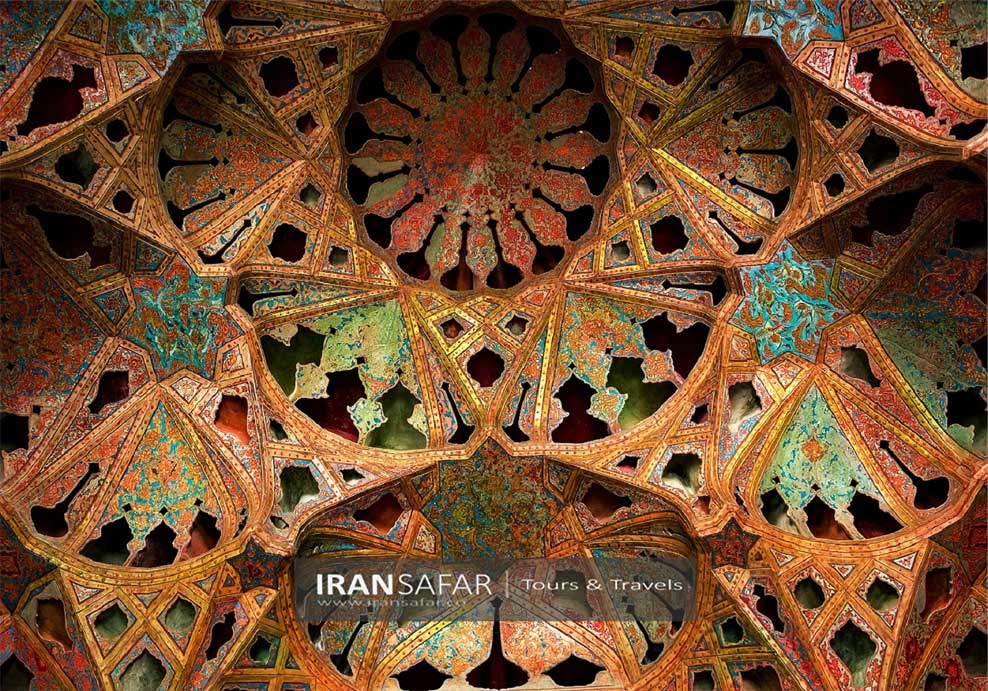 Cut out style stucco, Aaliqapu, Isfahan
Cut out style stucco, Aaliqapu, Isfahan
Stucco is one of the most important features of the architecture especially within the Safavid Period, and when flourished, the cut out style of design was invented. One of the finest and most captivating examples of the cut out style in this period can be found on the sixth floor of the Ali Qapu Palace (Music hall). This type of stucco is in the form of bowls, bottles and and ewer. These decorations have been innovatively incorporated into the ceiling of the room, which mesmerizes every visitor. The whole room is covered with cutout style decorations with the surface being painted with artistic floral and animal motifs by the most famous artists of that era. This is an inventive method of the Safavid Period and there is no sign of such artwork before Safavids.
Sheikh Lotfollah Mosque
Isfahan was chosen as the capital of Iran in 1598. At the same time, Urban development and constructions such as Chahar Bagh Street, Naqhsh-e Jahan Square, Imam Mosque, etc. It was during this period that Shah Abbas ordered the construction of Masjed-e Sheikh Lotfollah, and thus the foundation of the new mosque was laid on the ruins of an old mosque located in this place. Architect Mohammad Reza Isfahani took charge of building this mosque, which was able to build an amazing building in 18 years. Sheikh Lotfollah Mosque was reserved only for Shah Abbas and the royal family, and ordinary people were not allowed to enter it. It seems that Shah Abbas used to worship in this mosque every day from the opening of the mosque in 998 AH until the end of his life.
Sheikh Lotfallah was one of the greatest Shi’ite scholars who lived in the Jabal Amel region of present-day Lebanon. He emigrated to Iran with the official invitation of Shah Abbas I along with some other Shi’ite leaders to spread the teachings of Shi’ism as a new sect in Iran.
The layout of this mosque is unusual because it has neither a minaret nor a courtyard, and because there are steps leading up to the entrance. This was probably because the mosque was never a public mosque and was intended to serve as the worship place for the women of the shah’s harem. The sanctuary or prayer hall is reached via a twisting hallway where the eyes become accustomed to the darkness as subtle shifts of light play across deep blue tilework. This hallway is integral to both the design and function of the mosque because it takes the worshipper from the grand square outside into a prayer hall facing Mecca, on a completely different axis.
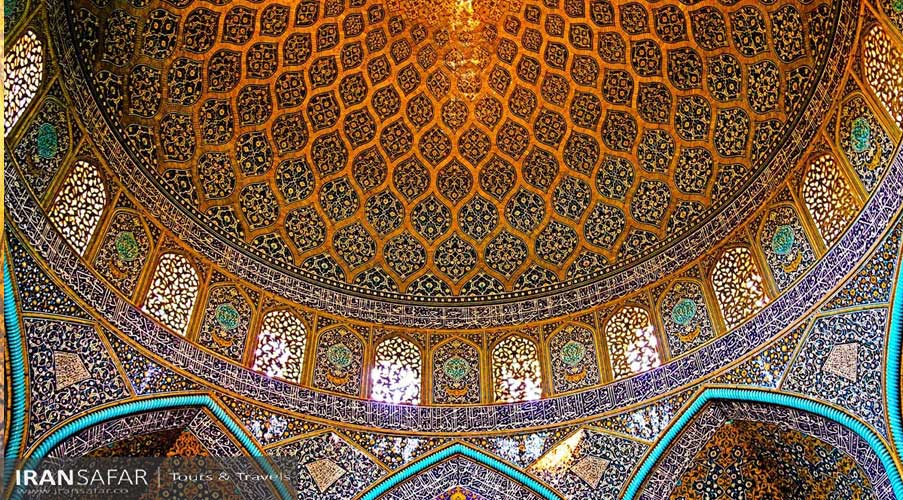
The main prayer hall of Sheikh Lotfollah Mosque amazes you with its art and spirituality. This sanctuary is a square with sides of 19 meters inside which, the complexity of the mosaics that decorate the walls and the extraordinarily beautiful dome, with its shrinking, yellow motifs, is a masterpiece of art. The shafts of sunlight that filter in through the few high, latticed windows produce a constantly changing interplay of light and shadow that enrich the space and give a tangible quality to empty air. The Mihrab is one of the finest in Iran and has an unusually high niche; a calligraphic montage names the architect and the date 1619 AD.
Isfahan Imam Mosque
Imam mosque, formerly known as Shah mosque or Abbasi grand mosque is the most important religious place of the Safavid period in the city of Isfahan, which is important both in terms of architectural grandeur and artistic features. Construction of the Abbasi Grand Mosque, which is located on the south side of Naqsh-e Jahan Square begun in 1611 by the order of Shah Abbas I and and lasted for 18 years. Though some fine decoration projects continued even after the king’s death.
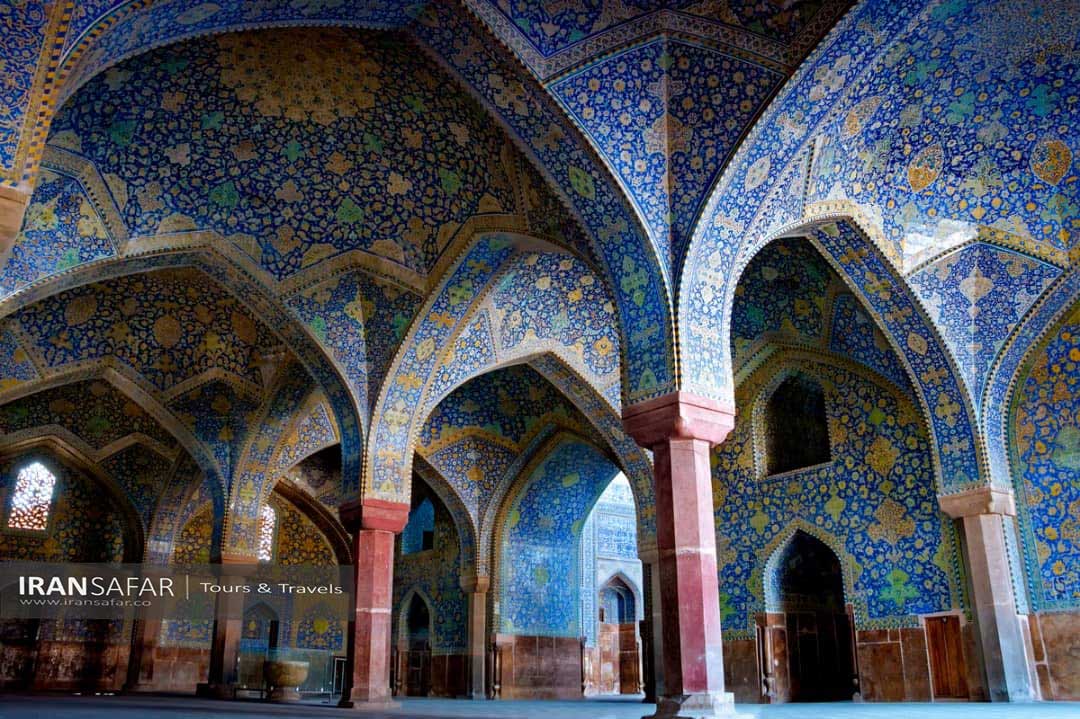 Imam Mosque interior, Isfahan
Imam Mosque interior, Isfahan
Imam Mosque Plan
The main entrance of this mosque is located on the south side of the square. There are other entrances in the neighborhoods around the building (for faster and easier access to the people of the neighborhood). Behind the entrance starts a corridor that leads visitors to the inner courtyard. It makes an angle of 45 degrees, aimed at aligning the mosque with Mecca while maintaining the integrity of the square.
The height of the huge dome of Imam Mosque is 52 meters, the height of the southern Iwan minarets is 48 meters and the height of the minarets at its entrance in Naqsh-e Jahan Square is 42 meters.
Here is the full plan of Imam mosque:
Isfahan Grand Bazaar
Dating back to more than 400 years ago, Isfahan Grand Bazaar is one of the largest and oldest known markets in the Middle East. This bazaar of Isfahan was built during the Safavid period and expanded during the Qajar period (19th century). According to some historians, it was the grand bazaar that shaped the architecture of Isfahan, but now this historical bazaar is limited to Naqsh-e Jahan Square to the Friday Mosque.
There are shops in this market that continuously offered the same goods from 400 years ago until today. This market, which in the past hosted various businesses such as bookbinding, box making, tailoring, weaving, blacksmithing and shoe making, is now mostly dedicated to selling clothes, sweets and souvenirs. Isfahan Bazaar is the best place to prepare souvenirs of Isfahan because you can find almost all the local foods and handicrafts of Isfahan.
Isfahan Bazaar has many entrances, but the most important entrance is Qeisarieh Gate in the northern side of Naqsh-e Jahan Square; You can easily find this entrance from afar thanks to its magnificent old wooden gate with 400 year old decorations on the top.
In Qeisarieh Bazaar, there are several mosques, baths, as well as schools (Madrasas).
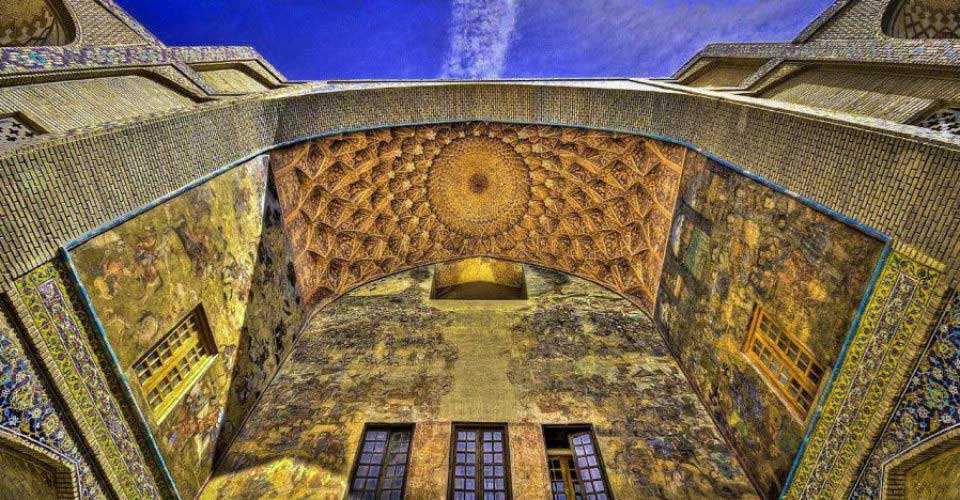 Qeysarie Gate, Isfahan, Iran
Qeysarie Gate, Isfahan, Iran
Apart from the existing buildings, there are other monuments in Naghsh-e Jahan Square that have gradually lost their use and disappeared. Marble capitals that probably came to Isfahan from Persepolis (one has been transferred to Chehel Sotoon and the other is in the National Museum of Iran in Tehran), 110 Spanish cannons (the booty coming from conquered Hormoz Island by Imam Qoli Khan) and a 40m high memorial column In the center of the square (which is completely gone today) are among them. Also near the Sheikh Lotfollah Mosque, there was a school called Khajeh Malek School (later Sheikh Lotfollah School) which was destroyed during the Qajar period.

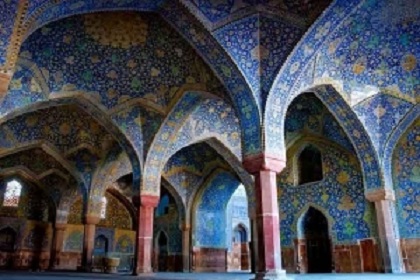
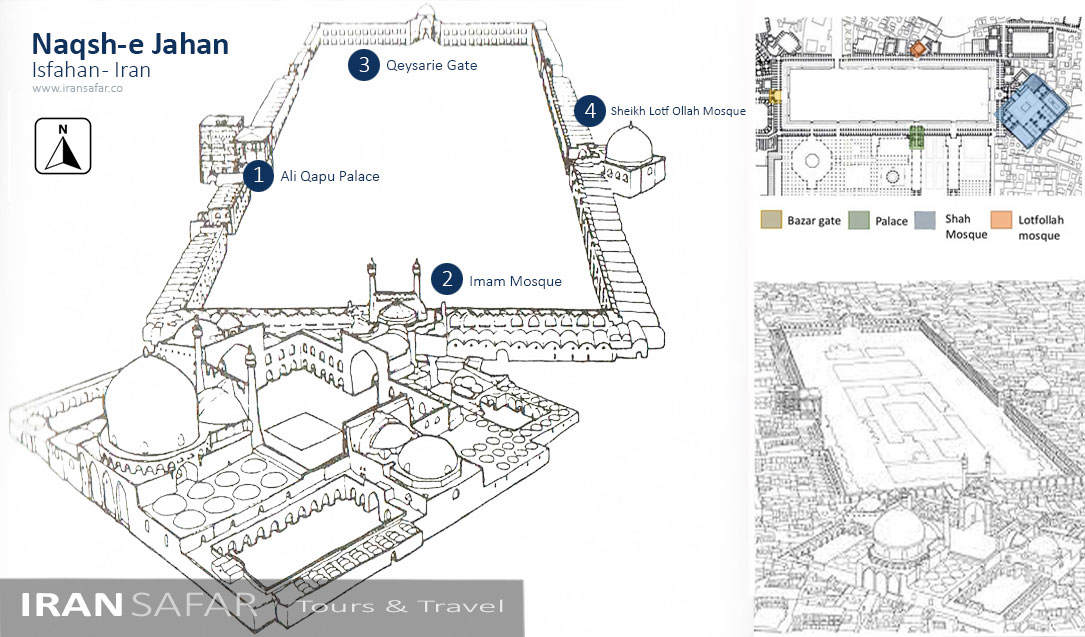
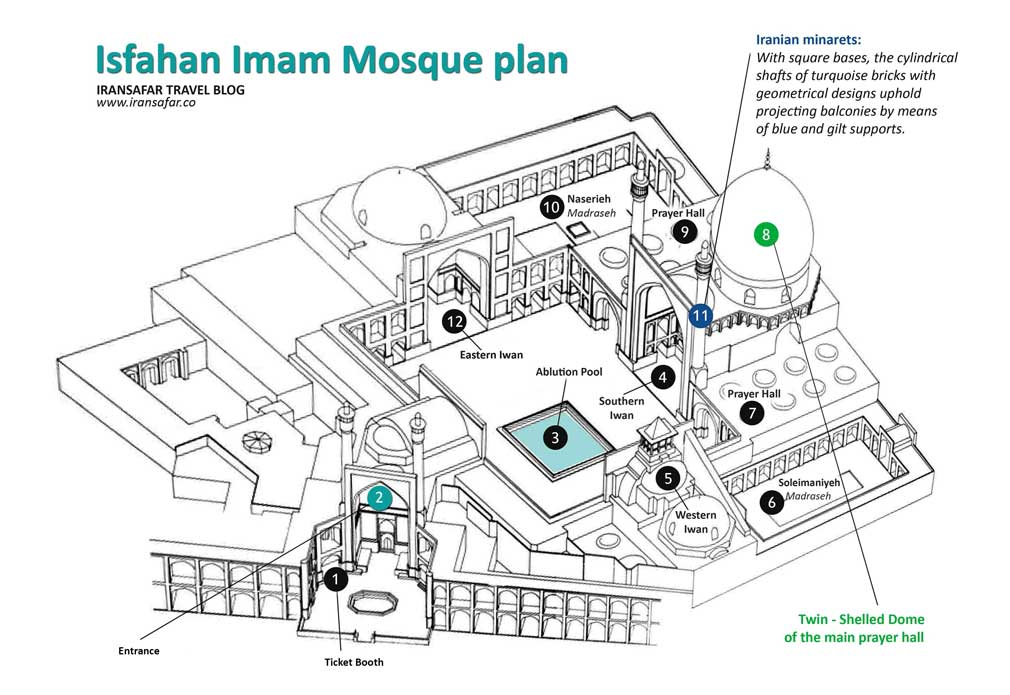

Comment (0)